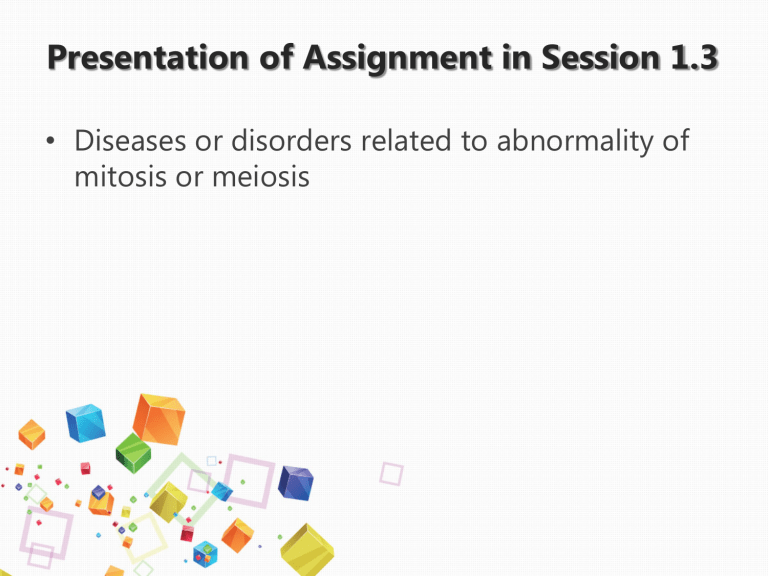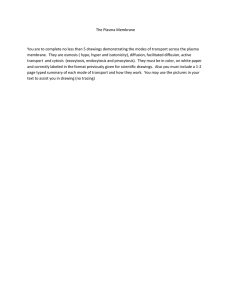
Presentation of Assignment in Session 1.3 • Diseases or disorders related to abnormality of mitosis or meiosis Session No. 1.4. The Cell: Transport Mechanisms Leila A. Allado-Ombat, PhD Biology Department College of Arts and Sciences Caraga State University, Butuan City Learning Objectives The learners: 1. describe the structural components of the cell membrane (STEM_BIO11/12–Ig-h-11) 2. relate the structure and composition of the cell membrane to its function (STEM_BIO11/12-Igh-12) 3. explain transport mechanisms in cells (diffusion, osmosis, facilitated transport, active transport) (STEM_BIO11/12–Ig-h-13) 4. differentiate exocytosis and endocytosis (STEM_BIO11/12-Ig-h-14) Words that you will encountered in this session • Plasma membrane phospholipid bilayer phosphate & glycerol (polar head) fatty acids (non-polar tail) transmembrane or integral and peripheral proteins Words that you will encountered in this session • Transport mechanisms across plasma membrane simple diffusion facilitated diffusion channel proteins active transport carrier proteins endocytosis, exocytosis Group Activity (15 mins) Presentation of the Result (3 mins per group) Cell membrane structure Video on cell membrane structure and function Membrane Structure 1. Describe the plasma membrane. 2. Discuss the importance of the plasma membrane and how indispensable it is to the life of the cell. 3. Explain how plasma membranes are arranged in the presence of water. 4. Enumerate structures found in a plasma membrane. Membrane Transport Mechanisms • Video on Transport Mechanisms Membrane Transport Mechanisms Diffusion Without Membrane Equilibrium Passive and Active Transport Movement of substance across membrane Facilitated Diffusion Osmosis Active Transport • Primary Active Transport (ion-pump) – used ATP Active Transport • Types of Secondary Active Transport Vesicular Transport • Three process of endocytosis Vesicular Transport • Exocytosis – facilitated by membrane-bound vesicle Quiz 1.What is the major component cell membrane? 2.Name of transport mechanism that requires channel and carrier proteins. What do you call the process that involved the movement of water through a semipermeable membrane? 4. If the red blood cell will be immersed in hypertonic solution, what will happened to the cell? 3. 5. A sugar molecule is transported from lower to higher concentration with the aid of ATP. What do you call this mechanism? Essay: Questions to Answer 1.Why does putting salt on meat preserve it from spoilage by bacteria? 2.Why do plant dies when applied an excessive amount of fertilizer? Thank you for listening and participating……. References • Plasma membrane structure video. https://www.youtube.com/watch?v=moPJkCbKjBs • Cell membrane transport. https://www.youtube.com/watch?v=gOxRXn5r9Jo • The plasma membrane. http://4.bp.blogspot.com/ • Types of membrane transport. http://biologyhq.com/biology/images/membrane-transport.png • The passive and active transport. http://www.tokresource.org/tok_classes/biobiobio/biomenu/membr anes/c8.7x17.transport.jpg • Diffusion without membrane. A drop of dye diffused in the water until equilibrium is reached. https://upload.wikimedia.org/wikipedia/) • Movement of substances across the cell membrane. • https://www.rpi.edu/dept/chem-eng/BiotechEnviron/Membranes/bauerp/perm.gif • Facilitated diffusion of molecules across cell membrane. https://upload.wikimedia.org • The state of plant and animal cell when exposed to different water concentrations. http://leavingbio.net/OSMOSIS%20AND%20DIFFUSION_files/image 009.jpg • Types of secondary active transport uniport, symport and antiport. http://www.perkepi.com/active-transport/ • The three processes of endocytosis. https://upload.wikimedia.org/wikipedia/commons/thumb/1/1a/End ocytosis_types.svg/2000px-Endocytosis_types.svg.png • The transport of molecules out of the cell as mediated by membrane- bound vesicles. http://www.vce.bioninja.com.au/_Media/exocytosis_med.jpeg •


